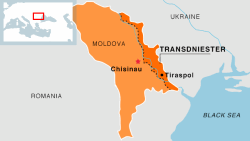A breakaway splinter of land laden with post-Soviet disaffection and aging heavy industry wedged among dysfunctional economies hardly sounds like a winning formula for exchange-rate tranquility.
Yet on the face of it, that's what tiny Transdniester has achieved over the past two years as its pro-Russian leadership in Tiraspol has clung improbably to a steady rate for its ruble against the U.S. dollar.
Despite the political and economic turmoil engulfing the rest of Moldova, from which separatists in Transdniester withdrew allegiance in 1990, leading after scattered fighting to one of the region's first "frozen conflicts." Despite a running war and economic collapse in eastern neighbor Ukraine. And despite the dearth of business from main trade partner and benefactor Russia, where global oil prices and Ukraine-related sanctions have gutted that economy and sent the Russian ruble into freefall.
Transdniester has advertised its spottily traded ruble at a rate of around 11 to the U.S. dollar since 2014, while its Russian namesake has lost around half its value against the greenback over the same period.
How can that be?
The territory's leadership has been able to fix its ruble's exchange rate in part because Transdniester's declaration of independence from Moldova isn't internationally recognized, and its currency is excluded from global financial markets.
But the largely Russian-speaking separatist region, which left Moldova in the U.S.S.R.'s dying days over fears that Chisinau would seek reunification with Romania, has also depended heavily on Russia's financial, political, and military support.
Analysts believe that the Transdniestrian ruble's exchange rate has been kept artificially high to avoid devastating price shocks for the region's 142,000 pensioners, who are thought to make up 40 percent of a total population that's estimated at around 300,000.
"If the dollar goes up, it will be extremely hard for us," a retired woman told RFE/RL's Moldovan Service in the Transdniestrian capital, Tiraspol. "Then what will be left of my 1,500-ruble [about $136] monthly pension?"
But cracks are starting to emerge.
Transdniester's central bankers warned in a statement on February 19 that their dollar reserves had fallen by $1 million, to below $19 million, in the first month of the year.
Economists say Transdniester is experiencing a deepening economic crisis -- due in part to its unreformed economy and in part to regional contagion.
Transdniester's gross domestic product (GDP) fell last year by 12 percent in annual terms, according to a report by Moldovan think tank Expert-Grup that describes the area's (and Moldova's) current economic growth model as "unsustainable." Incomes have dropped by almost one-third, the report says, reducing consumption by more than 20 percent.
The territory's pro-Moscow authorities appear to face a dilemma. Maintaining a strong currency could further hurt its economy, making its exports -- mostly steel, textiles, and resold Russian gas -- more expensive as some of its partners' currencies devalue. On the other hand, allowing the Transdniester ruble's devaluation could trigger an inflationary spiral that effectively impoverishes the population, which is largely dependent on imports.
Will The Gas Stop?
So far, the territory's separatist leadership has relied on Moscow's help. Russia maintains some 1,400 troops in the region -- a holdover from Soviet days -- and covers an estimated 70 percent of Transdniester's budget through direct or indirect aid.
"Directly, Russia's Finance Ministry sends financial assistance straight into Transdniester's state budget -- some $30 million annually, although it varies with time," Expert-Grup's Iurie Morcotilo says, adding that such money mostly funds schools or social payments.
"But the bulk of Russia's financial assistance is indirect and comes through allowing Transdniester not to pay its debts to [Russian state-owned gas monopoly] Gazprom," Morcotilo notes.
The Russian gas supplies are doubly convenient -- for Moscow and its allies in Tiraspol -- because they have allowed Russia to saddle Moldova (which, unlike Transdniester, is internationally recognized) with billions of dollars in mounting debt while the gas has actually ended up in Transdniester, where it has been resold locally or harnessed to produce electricity for export.
Morcotilo says the separatist government uses the money it earns from Russian gas -- hundreds of millions of dollars annually, according to numerous sources -- to finance its budget rather than repay any debts to Gazprom.
But Moscow's ability to underwrite the separatist region is likely to come under increasing pressure if oil and gas prices don't rebound and Russia doesn't get its financial house in order soon. Russian media reports last year suggested that Moscow had already refused some of Transdniester's requests for assistance.
Grudgingly Opening Up
Recently, Transdniester's leadership appears to have grudgingly looked to the West.
With Moscow looking on anxiously, Moldova in 2014 signed a political and economic Association Agreement with the European Union that calls for market and governance reforms. The trade portion of the document, known as the Deep and Comprehensive Free Trade Area (DCFTA), offers substantial economic advantages and came into force in January.
After Moldova's opponents in Tiraspol initially refused to accept the Association Agreement or any of its terms, instead demanding a separate political document, late last year Brussels greenlighted the implementation of the DCFTA throughout Moldova, including Transdniester.
But Transdniester reportedly had to pledge legal reforms in exchange for favorable trade terms from the EU, which already absorbs some 35 percent of the territory's exports.
"The parties reached an informal agreement under which the separatist leadership would implement an action plan to adjust its legal framework according to EU norms, but will not refer to the DCFTA in its domestic rhetoric lest it should be associated with their political course eastwards," Morcotilo explains.
















